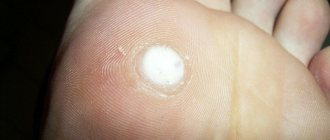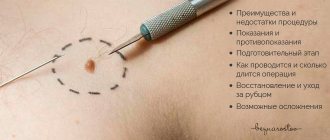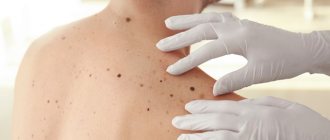The presence of moles on the body or face can bring significant discomfort to their owner. Large benign moles spoil the appearance of the skin, although they do not pose a threat to health. Often moles are located in areas of the skin where they are easily injured, which causes severe pain. Under the influence of mechanical damage, exposure to ultraviolet rays or hormonal changes, a mole can degenerate into a malignant formation (melanoma). At the moment, laser therapy is recognized as the most popular and effective method for removing moles and other tumors.
Is it necessary to remove a mole?
If a mole is in the way, it is removed. Quite a logical statement. And they are removed at home using flour and vinegar or scissors, or any other “folk methods”. Which, of course, you can’t do! Removing the tumor at home can lead to negative consequences, so if a problem arises, you should definitely contact a specialist. Under the influence of ultraviolet radiation or mechanical damage, neuruses can turn into melanoma, one of the most dangerous types of malignant tumors, with a high mortality rate. There are several signs of a “bad” mole:
- if it changed the color to a darker one or, conversely, became lighter;
- if it has become larger;
- if changes begin to appear, for example, cracks or peeling, as well as crusts, etc.;
- touching the nevus becomes painful or the itching and burning sensation subsides;
- if new formations appear around the main mole;
- blood or liquid appears on the surface of the nevus;
- heterogeneity of the nevus, the appearance of bumps, spots;
- if the hairs on the nevus begin to fall out (this is one of the signs of malignancy).
Indications for nevus removal may include:
- mechanical or chemical damage;
- unaesthetic appearance or huge size;
- malignancy (transition of nevus into a malignant state).
Moles that are located in places where they are easily damaged by shaving, scratching or rubbing (face, head, neck) have a high risk of developing into melanoma. Especially if you try to remove hairs from them or try to get rid of them yourself. It should be remembered that if there are a large number of moles on the skin, you should not stay in the sun from 11:00 to 17:00, since solar radiation is especially active at this time. You should also not visit a solarium if there are a large number of pigmented formations on your body.
What are moles: their features and reasons for their appearance
Moles (nevi) are benign formations that are a collection of pigment cells. More often, nevi are found with excess melanin, a pigment that changes the skin color to a darker one (coffee, red, brown, etc.). But there are also white birthmarks that indicate a lack of melanin.
As a rule, you will not find a single dark spot on a newborn’s body. There are exceptions, but most nevi are acquired. They appear at different ages, starting from 2-3 years, most often during hormonal surges in the body, that is, during puberty and pregnancy. Most nevi become attached to the body before the age of 24. In old age, birthmarks no longer appear, and some even begin to fade.
The reasons for the appearance of moles, in addition to hormonal changes in the body, may be the following:
- excessive exposure to the sun and solariums;
- genetic predisposition;
- penetration of viral infections into the skin.
There are a great many types of birthmarks. They are distinguished by different parameters: by size, depth of formation, appearance and color. But the most important classification is melanoma-hazardous and melanoma-hazardous types. The latter nevi can degenerate into malignant melanoma, so they require special attention and regular consultation with a specialist.
- Self-cleansing your face can be no less effective at home than a similar procedure performed by professional cosmetologists in a salon.
- Treatment of rosacea on the face is possible, and there are many different methods, which you can learn about in this article.
Classification of nevi (moles)
In size, nevi can be:
- huge (completely or almost completely covering some part of the body);
- large (more than 10 cm);
- medium (less than 10 cm);
- small (no more than 15mm).
In addition, nevi are divided into epidermal, intradermal and borderline. Epidermal nevi
are a cluster of melanocyte cells on the top layer of skin (epidermis).
Intradermal nevi
are located deeper than the epidermis.
Borderline nevi
are located at the border of the epidermis and dermis. Based on a set of parameters (color, location on the skin, shape, etc.), nevi are divided into:
- hemangiomas
- bluish, pinkish or red nevi, consisting of involuting endothelial cells; - anemic nevus
- a light area of skin where blood vessels are underdeveloped; - non-vascular
- grouped or single plaques with a rough surface, of various shapes and colors (from grayish to black); - Setton's nevi
are benign formations located in the circle of depigmented epidermis; - nevi of Ota
- a single spot or several merging spots that are dark blue in color; such a nevus often forms in the area of the cheek, eyelid and upper jaw; - nevus of Ito
- looks approximately the same as nevus of Ota, but is usually located in the supraclavicular and scapular region; - blue
- nevi slightly rising above the epidermis, having a blue or bluish color and a smooth surface; - dysplastic
- pigmented moles, 4-12 mm in size, usually of an unclear shape and a brownish or brownish tint; - Becker's nevus
is a hyperpigmented area of skin with many hairs (more common in the male half of the population).
Dermato-oncologists classify moles into melanoma-hazardous (which can later turn into a cancerous tumor) and melanoma-hazardous (which do not threaten health). In addition to moles, there are also warts and papillomas. Some people confuse them (and given the variety of types of moles, this is not surprising) and believe that they are one and the same thing, but this is completely wrong.
A mole is a pigmented area of skin. Papilloma is a manifestation of the human papilloma virus. There are more than a hundred varieties of HPV, some of which are transmitted not only through sexual contact, but also through contact with an HPV carrier. According to statistics, more than 60% of people are carriers of HPV. A wart is a type of papilloma, mostly harmless, but rather unaesthetic in appearance. Not only a specialist, but also an ordinary person can usually distinguish a wart from a nevus. Despite the availability of wart removal products in pharmacies, it is still better to visit a doctor, since an incompletely removed wart can behave completely unpredictably. If you remove it yourself, the likelihood of inflammation or developing skin cancer is too high to risk it. Before getting rid of a nevus, you should also consult a doctor and do a histological examination of the tumor. You should not go to cosmetology salons; this is fraught with great risk, since cosmetologists have neither knowledge of skin oncology nor experience in diagnosis. It is best to contact a mole removal center located in any major city.
Why do you need to remove moles?
Initially, all moles on the human body are safe. Problems are usually associated with their degeneration, which can lead to skin cancer. In this case, when there is a risk of the formation of a malignant tumor, a consultation with a dermatologist is necessary, who will decide whether it is necessary to get rid of the nevus, how quickly it needs to be done, and which removal method is best to choose.
Symptoms of the transformation of a harmless mole into a formidable enemy can be suspected by regularly examining your body. Be careful and contact your doctor immediately if you experience any of the following symptoms:
- change in the color of the pigment spot (darker or lighter than usual), the appearance of heterogeneous color inclusions on it;
- transformation of the shape and structure of the mole (becomes denser or looser, more convex);
- nevus increase in size;
- unpleasant sensations at the site of the birthmark: itching, burning, skin tightness;
- suspicious appearance of the nevus: redness, peeling, swelling, bleeding, appearance of a “crust”;
- blurred contours of a mole;
- the skin in the nevus area loses its pattern and becomes as if “polished”;
- hair loss on a hair-bearing mole;
- the appearance of growths (on the nevus) or a group of small formations similar to a mole (near the nevus).
It is worth noting that some factors provoke the degeneration of a benign tumor into a malignant one. Remember these simple rules - and the risk will be minimal:
- do not be in the sun or in the solarium too often and for a long time, protect areas with large and suspicious nevi from exposure to ultraviolet radiation;
- Be careful not to catch or damage them. Trauma is also a cause of dangerous degeneration.
Doctors often recommend getting rid of a growth if it is located in a problematic or traumatic location (for example, on the head, in the armpit, on the eyelid, on the neck, in the perineum). But without an examination and appointment of a specialist, you should not make such decisions yourself.
Another reason for removing birthmarks is the aesthetic side of the problem. If a mole is in a visible place, has a large size or an unsightly appearance (for example, hanging nevi), then many decide to get rid of it. As a rule, this applies to formations on the face and neck. But the day before, be sure to visit a specialist who will advise how best to do this.
What to do if a nevus is accidentally damaged
If a nevus is accidentally injured, first of all, you need to moisten a cotton swab with hydrogen peroxide and stop the bleeding, and then consult a doctor. When the mole is completely torn off, it should be preserved and shown to specialists so that they can conduct an examination to detect cancer cells in the nevus. Signs that a traumatized nevus was malignant:
- the mole or the place where it was itches, hurts or burns;
- the skin around the mole is inflamed;
- hairs from the damaged nevus began to fall out;
- nodules appear at the site of the nevus;
- the spot begins to increase in diameter;
- the skin where the mole was located changed color;
- bleeding in the area of the nevus does not stop or resumes.
Benefits of the procedure
Even if a large mole does not cause inconvenience to a person, it is in any case advisable to remove it in order to avoid problems in the future. Elimination of nevi using laser beams is considered the safest method.
In addition, there are many more advantages of this cosmetic procedure:
- complete painlessness (the problem area is anesthetized),
- does not require penetration into the skin,
- only pigmentation is removed, healthy cells are not involved,
- absence of bleeding, noticeable damage, scars and cicatrices,
- eliminates the possibility of relapses,
- fast healing,
- the ability of a laser to accelerate the process of skin regeneration.
Removal of minor moles is carried out without anesthesia, and the consequences of such an operation are minimal. The possibility of infection entering the wound is also eliminated, since extremely high temperatures are involved in the process.
How is the tumor removal procedure performed?
First, the site of exposure is treated with an antiseptic (medicinal alcohol, etc.). Next, a local anesthetic (lidocaine) is used. Then, depending on the method of eliminating the mole, it is either cut out with a scalpel or laser, or cauterized with electric waves or liquid nitrogen. Then the site where the mole is removed is treated with ointment or potassium permanganate. If a surgical method was used, sutures are applied. After a certain time of 7 to 20 days, everything heals and new skin forms.
Reviews and consequences
As a rule, there are no unexpected consequences after laser surgery, since the procedure is carried out quite quickly and without significant problems. Possible complications include the formation of a protective crust and subsequent pinkish spot. Also, after removing large nevi, a small scar remains. All other manifestations disappear after a week. It is worth noting that the duration of the rehabilitation period depends on the complexity of the operation.
The risk of complications increases if a person trusts an inexperienced doctor. After the operation, the wound may be very itchy, characteristic discharge, high temperature and swelling will appear. All this indicates incorrect care or errors when performing the laser procedure. Sometimes swelling and swelling occur due to an allergic reaction.
Relapse, that is, the reappearance of the nevus, occurs due to incomplete removal. Such interference causes the malignant course of the mole. Women with hormonal problems may experience inflammation and bleeding. The result of non-compliance with care recommendations is scars. Otherwise, most patients note rapid and traceless healing of the wound.
What mole removal procedures exist in modern medicine?
After conducting a study of the formation, you need to choose exactly how to eliminate the nevus. At the moment, medicine provides the following methods for removing moles:
- surgical
removal of a mole; - removal of moles with nitrogen ( cryodestruction
); - removal of a mole by electrocoagulation
; - laser mole removal – laser therapy
; - radio wave excision
– getting rid of a tumor using high-frequency waves.
Let's take a closer look at the advantages and disadvantages of the above methods.
Surgical removal
It is one of the most reliable methods for removing skin tumors. The surgeon cuts off the mole with a scalpel at skin level or a little deeper and cauterizes the wound. An antibiotic and a bandage are then applied. Or the surgeon removes the mole and its surrounding area. The size of the area removed depends on the surgeon's opinion of the possibility of cancer developing. After cutting out a large area, stitches are placed. After some time, the doctor will remove the stitches on the surface of the skin.
Pros:
- if precise technology is followed, there is no likelihood of relapse;
- excision occurs with partial removal of the surrounding skin, which also prevents the risk of re-growth;
- it is possible to analyze the material remaining after removal for histology;
- reasonable price of the procedure;
- There are practically no contraindications.
Minuses:
- scar after mole removal;
- long period of healing and recovery.
Cryodestruction
This method is used mainly for small formations. Removal of moles of papillomas is also carried out using this method. This procedure is suitable for removing moles in visible places. Using an applicator, liquid nitrogen is applied to the neoplasm, causing it to thicken and turn white. Then a bubble appears at the cauterization site, which subsequently decreases and turns into a crust. Within 14 days, the crust falls off and pink skin remains in place of the mole.
Pros:
- 100% painless;
- no scars or scars remain on the skin;
- inexpensive;
- quick removal;
- minimal risk of infection.
Minuses:
- it is difficult to predict the area of distribution of liquid nitrogen and there is a possibility of damage to healthy tissues by cold;
- for the same reason (the unpredictability of the spread of liquid nitrogen), the nevus may not be completely removed, which means repeated removal will be required;
- the inability to conduct a histological examination of the removed material, which increases the risk of not finding out about melanoma or skin cancer in time.
The disadvantages of cryodestruction are quite significant, so before removal by this method, you should carefully weigh the pros and cons.
Removal with an electrocoagulator
Electrocoagulation successfully fights interfering moles, HPV, warts, complicated acne and many other ailments. When removing moles with an electrocoagulator, the doctor selects the power of the device, which, using a loop-tip, acts on the mole with an electric current. This method takes about 20 minutes, sometimes less, depending on the diameter of the nevus.
Pros:
- absence of blood and risk of infection;
- painlessness (local anesthetic is injected);
- the ability to submit the remaining material from removal for histological analysis;
- the ability to control the depth of removal of the epidermis and dermis.
Flaw:
- A crust forms at the removal site, which falls off in a week or less, but may leave a white spot (therefore, the procedure is not always suitable for particularly noticeable areas).
Laser therapy
Laser therapy is excellent for removing small tumors. Nowadays, laser therapy is recognized as the most popular and effective method for removing moles on the face. The essence of the procedure, like the surgical method, is to completely eliminate the mole. In order to remove a mole without damaging the surrounding skin, a beam with a certain wavelength is selected. The action of the beam is aimed exclusively at the melanin contained in moles and birthmarks.
Advantages:
- painlessness of the procedure;
- no chance of relapse;
- high precision of beam direction, helping to avoid damage to adjacent areas of the skin;
- the operation lasts several minutes;
- due to cell stimulation with laser, healing occurs in the shortest possible time;
- the ability to eliminate several nevi in one session;
- no bleeding;
- no special care required after surgery;
- a short rehabilitation period, during which you can play sports and swim, you just need to avoid direct sunlight on the operated area.
Flaw:
- inability to send removed material for histological examination. Therefore, the decision to remove a mole with a laser is made only when it is confirmed that the mole is non-cancerous.
Radio wave excision
It is carried out using a special device that reproduces high-frequency radio waves. With its help, you can remove formations of any size and in any quantity. This method includes the same advantages as laser therapy, but in addition allows you to take material for histological examination. It can rightfully be recognized as the safest and most effective way to remove moles in modern medicine.
When not to have surgery
The laser method of removing moles is considered a safe and painless non-invasive method. However, it also has certain limitations in use caused by the individual characteristics of the patient’s body and skin. The following contraindications are noted:
- acute skin inflammatory reactions, especially infectious types;
- malignancy of a mole;
- significant neurological disorders;
- significantly reduced immunity;
- pregnancy;
- menstruation in women;
- oncology of any localization.
Contraindications to mole removal
Removal of moles is prohibited if the patient has an exacerbation of a chronic disease, a disease of the cardiovascular system, or the part of the skin being operated on looks unhealthy. In addition, certain methods of nevus removal have contraindications. For example, surgical removal will not be performed if the patient has:
- herpes;
- infectious or inflammatory disease.
Removal with liquid nitrogen is also prohibited in case of the above problems, as well as if a malignant mole or individual intolerance to cold is detected in the patient. Contraindications for laser removal
:
- photodermatosis (allergic reaction to solar ultraviolet radiation);
- suspicion of malignancy;
- activation of herpes;
- pregnancy;
- menstruation on the day of removal;
- change in body temperature (even slight);
- infectious or inflammatory disease.
Radio wave removal
of moles is excluded if:
- have herpes;
- malignancy of the skin occurs;
- the patient is pregnant or breastfeeding;
- the patient has a pacemaker;
- diabetes;
- pulmonary heart failure at the stage of decompensation.
The essence of the problem
A mole, or nevus, is a benign skin formation. It occurs when the pigment melanin accumulates, in the formation of which the pituitary hormone plays a major role. Given this role of this important element of the endocrine system, it is believed that the appearance of moles is largely determined by hormonal changes. This conclusion is confirmed by the increased formation of nevi in adolescents during puberty, in pregnant women and during menopause. In addition, an increased risk of their occurrence has been established with excessive exposure to sunlight, as well as in people with light skin.
Most often, moles do not pose any danger to human health and remain quietly in their place throughout their lives. People can be irritated by the aesthetic side of the problem, especially when such defects are located on the face and are of significant size. At the same time, nevi are not always so harmless. In some cases associated with exposure to solar ultraviolet radiation or frequent mechanical damage (friction, abrasion), there is a possibility of transformation of moles into a malignant formation with all the ensuing serious consequences.
Consequences of mole removal
There are often no adverse effects from mole removal. Any oncology center for mole removal will take care of its patient (and its reputation) and the nevus will be removed without any problems. The consequences partly depend on the human body itself and its age. If the procedure for removing a nevus included subsequent care for it, then you should definitely follow the doctor’s recommendations in this regard. Inadequate care of a mole during the recovery period can have consequences in the future. The treatment and healing time of a mole depend mainly on the method of removal. If a crust has formed at the site of a mole, it should under no circumstances be peeled off, as this will slow down the healing process and create the possibility of infection in the body. Most often, after removing a tumor, you cannot take a bath, go to a bathhouse or sauna, or swim in a pool. Do not apply decorative cosmetics to the area where the nevus was. You can use sunscreen, but only with your doctor's permission and when necessary. The mark from the removed mole should be protected from the sun until the skin there acquires the same color as the adjacent area. If you still have scars after the procedure, you can consult your doctor about scar healing products. You can also try lubricating the area with cocoa butter, which promotes accelerated regeneration and healing. If a mole was removed for reasons other than aesthetics, it is advisable to regularly examine the remaining moles for changes and monitor the appearance of new nevi.
Recovery period
After correct laser treatment, complete tissue restoration occurs 7-10 days after surgery. Relapses of the lesion, as a rule, are not recorded, but to completely eliminate new accumulation of melanin, certain recommendations should be followed:
- During the regeneration period, the treated area of skin should be kept at rest, excluding the effects of friction from clothing or shoes.
- The operated area should not be wetted for 13-15 days.
- It is necessary to avoid exposure of the affected skin to direct sunlight; a cream with an increased ultraviolet protection factor should be applied (you can sunbathe no earlier than 25-30 days after the procedure).
- The use of ointments, creams and gels for any purpose must be agreed with a doctor.
- The integrity of the protective scab at the site of exposure should be ensured as much as possible.
Video shows the consequences of laser mole removal:
Here you can read about laser removal of ingrown toenails.
What are the possible complications?
Despite all the safety of laser technology, unpleasant consequences are possible, which are caused by the individual characteristics of the body and violations during the procedure. After laser removal of a mole, the wound should heal within 4-6 days, and the scar itself should be barely noticeable.
After the procedure, the following consequences are recorded:
- The appearance of a swelling (tubercle). This manifestation can be considered a normal physiological reaction of healthy tissue to the wound healing process. Such swelling should become covered with a crust, and it will completely disappear on its own after 8-12 days.
- Inflammatory reaction. If the inflammation lasts no more than a day, then this phenomenon can be considered a normal reaction of sensitive skin. If the process lasts longer, it is necessary to take measures to cure it.
- Formation of a noticeable scar. This is an abnormal phenomenon, which is most often associated with a violation of the integrity of the protective crusts during the recovery period.
- Itching and pain syndrome. Such symptoms, as well as redness at the site of manipulation, occur only when the procedure is performed poorly. These complications require contacting a doctor to determine the causes and treatment.
- The most dangerous consequence occurs if laser exposure was carried out without proper histological examination, and the benign nevus has already begun to transform into a malignant formation. In this case, radiation can speed up the process, and removal of such pathologies is carried out only surgically. It is quite risky to leave some of the abnormal cells, i.e. incomplete removal of a mole. In such circumstances, the remnants of the nevus in the depths of the integument can become the focus of the formation of a neoplasm.
Cost of mole removal
The price for mole removal depends, first of all, on the chosen removal method. The second important factor is the size of the operated nevus. Naturally, prices for the same procedure will vary depending on the clinic chosen. Below are approximate prices for mole removal.
- Laser removal of nevus up to 1 cm in diameter – from 1300 rubles
- Laser removal of nevus larger than 1 cm – from 2300 rubles
- Laser removal of small multiple rashes (up to 5 pcs.) – from 2800 rubles
- Laser removal of small multiple rashes (from 5 to 10 pcs.) – from 3400 rubles
- Laser removal of small multiple rashes (more than 10 pcs.) – from 4500 rubles
- The price for removing a mole with liquid nitrogen ranges from 300 to 2000 rubles
- Removal of a tumor by electrocoagulation costs from 2000 rubles
- Surgical removal of a nevus up to 0.5 cm costs from 1,500 to 3,000 rubles
- Surgical removal of a nevus larger than 0.5 cm costs respectively from 3000 to 5000-6000 rubles
In addition to the cost of the procedure itself, it is worth considering the cost of a doctor’s consultation and the cost of preliminary studies and tests, which, in general, will amount to at least another 1,500 rubles. If you find a large number of unknown neoplasms or modifications, you should immediately consult a doctor. Any skin formation can cause the development of skin cancer, so you should not brush off any discomfort associated with nevi. The sooner a problem is identified, the easier it will be to solve it, so don’t neglect your health and don’t waste time on it. The above pros and cons of each removal method will help you decide which one is right for a particular person.
But do not forget that they all have contraindications, and only a qualified specialist can approve a specific method after conducting an examination. It is worth recalling once again that it is worth taking any actions and measures in relation to moles only in special oncology centers for the removal of moles, and not in beauty parlors . Take care of yourself, value your health, and your body will repay you in kind.
Features of laser removal on the face
When removing a mole on the face, a person expects a smooth and clean skin surface. The laser method is the best option for this purpose. After a short period of rehabilitation, there are practically no noticeable traces of the operation left on the face. Only in the first days will a slight deepening be noticeable. The only caveat is that it is not always possible to completely remove a pigmented area from the face. For example, moles on the nose can grow deep into the skin tissue.
The specialist diagnoses the nevus and analyzes the possibility of eliminating the defect. In some cases, the limitation is the diameter and depth of the mole. If the formation is located far in depth and to the sides, then a significant amount of skin will be removed. It is impossible to carry out such an operation without leaving a trace. You should also take into account the doctor’s qualifications and his capabilities, because not everyone has the ability to accurately eliminate small formations.











